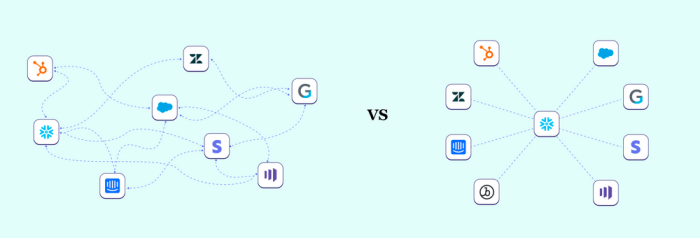Regardless of your business unit – fresh, reliable data is critical to success.
But raw data on its own is overwhelming and useless without context, so teams are often forced to choose between trusting their data and being able to take quick action on it.
So, what’s the solution? Operational analytics.
Traditional analytics relies on using your data to understand business operations. Operational Analytics (OA), on the other hand, is all about using your data to drive business operations.
OA lets you sync data directly from your data warehouse into the frontline tools your team relies on every day.
So, it tactically allows you to do more, including driving better automation, better understanding between cross-functional teams, and more effective workflows.
The modern data stack is made up of four sections: data integration, data storage, data modeling, and data activation.
A simple data stack might have the following tools filling out each of these four sections: Fivetran, Snowflake, dbt, and Census. Add Chameleon to the mix as your data destination, and you’ll be able to create data-based user flows in-product to drive product adoption.
With OA in place, you’ll be able to create a consistent picture for everybody in every tool and reach your customers at any scale at just the right time. There are also specific benefits for each of your teams, and we cover them in detail below 👇
Why you should upgrade your traditional analytics approach
Traditional analytics relies on using your data to understand business operations, which often boils down to just getting your data into another dashboard or report that requires hours of deliberation from your team to determine the next best action. It typically helps you answer questions along the lines of “Is this product line generating revenue?”.
Operational Analytics (OA), on the other hand, is all about using your data to drive business operations. It lets you sync data directly from your data warehouse into the frontline tools (like Salesforce, HubSpot, and Marketo) your team relies on every day, so you can answer questions like “Which support ticket should I tackle first?”
Clearly, it isn’t just another “digital transformation” trend – Operational Analytics is centered on building a shared understanding between teams based on trusted, highly-accessible data from your warehouse. So, it tactically allows you to do more, including driving better automation, better understanding between cross-functional teams, and better operational efficiency.
And when implemented well, this flow of real-time data (from data warehouses to people who can actually do something with that data) becomes an undercurrent of insights powering important daily decisions, including 👇
Prioritizing support tickets by product usage
Using sales outreach data to segment audiences for marketing email drip campaigns
Plugging early churn indicators right into your customer relationship management platform
Using data insights to trigger relevant and contextual in-product messages with your product adoption tool to keep users engaged and increase retention.
Basically, Operational Analytics puts your organization’s data to work so everyone can make smart decisions about your business.
Breaking it down
The modern data stack is made up of four sections: data integration, data storage, data modeling, and data activation.
A simple data stack might have the following tools filling out each of these four sections:
Data Integration: Fivetran, an ETL (extract, load, transform) tool, will integrate all your data sources into your data warehouse.
Data Storage: Snowflake, a data warehouse, can store structured and unstructured data all in one place.
Data Modeling: dbt, a data modeling tool, helps you manage your data with a library of data models, which will make your data usable for different purposes.
Data Activation: Census, a data automation tool, or a reverse ETL (rETL) tool, will pull your usable data out of your data warehouse, validate it automatically, and send it to the tools that need it (like your CS rep’s CRM).
A conceptual way to think of this data stack is as a hub and spoke system, where Snowflake serves as a single source of truth “hub” for all data. Then, from this hub extends “spokes,” or places that data comes from and places that data goes to (e.g., CRMs, marketing automation platforms, A/B testing software, or product adoption platforms).

In this setting, it’s Fivetran’s job to move data from the spokes into Snowflake. Once the data is in Snowflake, dbt helps make all that data ready for use, and finally, Census moves the prepared data from Snowflake to the spokes it needs to go to. Then you can add a tool like Chameleon to the mix as your destination, to create UI patterns and build any user flows in-product no matter how customized they need to be.
Traditional analytics sends data out of your data warehouse for very specific tools, like a BI platform. Operational analytics sends data out of your data warehouse to just about whichever spoke needs it. They’re essentially different types of spokes that extend out of a single source of truth (your data warehouse), so you can unlock a truly virtuous cycle of data, from raw data to modeling to deployment into apps and back.
But can’t tools bring your data from A to B?
Operational Analytics is more than just a new tool to adopt or a new pilot for one team in your org to try out, it’s about changing how you think about working with your data. And once you reach a point of having a few customers’ data flowing into your data warehouse, you’ll quickly find the limitations of the individual tools you’re currently using, like these:
You’re limited by the data you have in that system. For instance, if you’re running a complex email drip campaign in Marketo, you need to segment your audiences using Marketo.
You have to connect the dots on your own. Say you need to call a customer to prevent churn because they haven’t used your product in a while. First, you need to identify that they’re not using your product in your product analytics tool, and then you need to convey that message to your CS team so they can make the call.
To combat these issues, companies will often use spreadsheets as a workaround. Sure, that can work well… up to a point. But once you start dealing with any sort of scale (even something as small as 5-10 customers), the data quickly outgrows the capabilities of a Google Sheets doc and some filtering.
And what’s worse is that you’re relying on overworked operations people to manage how those tools work together. There’s a marketing operations person wrestling with Marketo, for example, day in and day out, managing these audiences and lists manually. There are CS reps swapping between dashboards, email, the help desk, and spreadsheets, trying to prioritize what to do next.
Luckily, Operational Analytics not only provides a way to overcome these limitations at scale but also allows your data team to step up and take a more proactive role in how your business uses data. In fact, you can automate all of these daily brain-draining tasks so these employees can actually start doing their work.
What you can achieve once you add in OA
When you invest in Operational Analytics, you can achieve some truly amazing results 👇
The ability to deliver trustworthy data and insight from one central hub (not just A to B, but A to everywhere).
The ability to create a consistent picture for everybody in every tool.
The ability to reach every one of your customers at any scale at just the right time.
The ability to bridge the data gap and human gap between data and ops teams.
These outcomes are what make it possible to drive PLG at scale, craft personalized experiences for users, and reduce cost per acquisition across all your marketing campaigns.
Not to mention that it makes every function (data, marketing, customer success, and sales) within the company a data-driven one. Let's take a look at the specific benefits for each team.
OA for data teams
Operational Analytics isn’t just about helping data teams do less pipeline babysitting (e.g. custom integrations work), it’s about helping them become better strategic teams within the company and take the seat at the table they deserve.
This means data teams will:
Spend less time doing integration work and more time building cutting-edge models and doing interesting analyses
Better advocate for the skills of their team and establish themselves as key stakeholder
Delight data consumers (and, ultimately, customers) and make it easier for everyone to get access to the data they need
Provide fresher, more accurate data for everyone’s work
Ensure they have total control of data pipelines from end to end
OA for marketing teams
But it’s not just data teams that reap the benefits. Access to truly data-driven marketing operations can make all the difference in how your marketing team operates.
This way, your marketing team will be able to:
Successfully load data in Salesforce workflows to power lead scoring, MQLs, and PQLs
Tap into the full functionality of their existing tools (and able to start using shiny new tools they’ve always wanted to try)
Drive better segmentation and personalization through actionable user data
Embrace faster experimentation efforts through ad targeting and user propensity scoring
Completely cut out their need for custom code and email CSV uploads
OA for customer success teams
When it comes to customer success teams, data is critical. It often means the difference between being able to meet retention and adoption goals and watching customers slip away.
So, by embracing Operational Analytics, your CS teams can:
Improve collaboration between customer success and sales to reach customers with a unified front
Create account type and hierarchical ticket prioritization models
Make critical data truly self-serve for the customer success team
Reduce response times for common support issues from days to minutes
OA for sales teams
Operational Analytics gives sales teams access to the data they need to not just convert customers, but build lasting, loyal relationships with them at every step of the sales journey.
After all, as any company embarking on PLG knows, it’s not just about optimizing one touchpoint, but ensuring every interaction with your customers is timed perfectly. Here’s how your sales team can reach the right customers with the right message at the right time through Operational Analytics.
With OA in place, your sales team will be able to:
Understand what features customers love most (and where each customer is in their lifecycle)
Create lead scores with fresh, real-time data
Empower real-time sales forecasting in destinations like Google Sheets
Create a shared understanding of customers and the organizations they belong to
Give sales teams access to high-quality behavioral data in the tools they rely on
As everyone in your org becomes an Operational Analytics practitioner and gets better access to trustworthy data, the sky's the limit for what they can do with that data.

Getting started with OA
Unlike traditional analytics, Operational Analytics provides trusted, highly-accessible data to all your teams so they can drive business operations. It’s more than just a new tool to adopt – it’s about changing how you think about working with your data and bridging the gaps of the individual tools you’re currently using.
When you invest in OA, you can see some tremendous results, not just within your data team, but across all teams in your organization.
Want to join some of the brightest minds in data, learn the skills needed to support the future of operational analytics, and get support for the tools powering the future of data? Join The Operational Analytics Club.
Looking to start driving PLG at scale, crafting personalized product marketing, and reducing cost per acquisition across your campaigns? Book a demo with Census to start operationalizing your analytics. Then use Chamelon to extract meaningful insights and implement them in your product adoption strategy.
Streamline your data flow
Integrate your modern data stack with Chameleon for a streamlined flow of data between your tools, personalize the in-app guidance, and see your product adoption rates go high!
Your Guide to Operational Analytics: The Modern Way to Work With Your Data
This article is written by Nicole Mitich, Content Marketing Manager at Census. She's carried a love for reading and writing since childhood, but her particular focus is on streamlining technical communication through writing. She loves seeing (and helping) technical folks share their wisdom.





